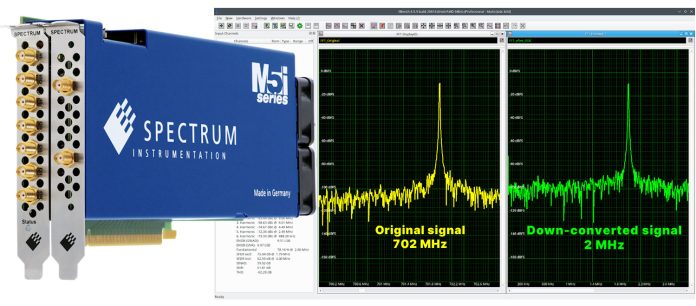Spectrum Instrumentation launches DDC processing to convert RFsignals down to baseband signals.
Spectrum Instrumentation’s complete line of PCIe digitizer card scan now perform Digital Down Conversion (DDC) thanks to a low-cost option that uses an external GPU-card for continuous “on-the-fly” processing. DDC is a powerful technique that is commonly used in a wide range of communication systems, like digital radio, radar, mobile telephony, space or satellite communications. In the DDC process, RF or Microwave signals are converted to baseband, which contains the signal of interest. The conversion dramatically reduces the resultant data set while also improving signal quality and measurement accuracy. Spectrum Instrumentation has 48 different PCIe-based digitizers (with sampling speeds from 5 MS/s to 10 GS/s) that can run the new DDC function, so customers can select the “Perfect-Fit” model for their application.
DDC with on-board FPGA or external GPU card?
Most digitizer DDC implementations use on-board FPGA (Field Programmable Gate Array) technology. The incoming analogy signals are converted to digital data before being passed to the FPGA for down conversion. The approach is fast and efficient but comes with limitations. It needs large and expensive FPGA technology as well as purposely created firmware. Customizing the firmware is also a challenge, requiring specialist firmware development knowledge and costly software tools.
Fig. 1: A Spectrum M5i digitizer and frequency domain screenshots of a 702 MHz signal before and after DDC. Data is continuously streamed at 12.8 GB/s to a GPU for on-the-fly processing prior to display with Spectrum’s measurement software, SBench 6.
The approach from Spectrum Instrumentation removes these hurdles. By using the company’s SCAPP (Spectrum’s CUDA Access for Parallel Processing) software development kit, the data acquired by the digitizer can be streamed over the digitizer’s PCIe bus directly to a CUDA-based GPU. The GPU, which can have thousands of cores working in parallel, then allows the processing software to be created using the C/C++ language. This makes for a much easier DDC implementation as customization can be made with normal programming skills. Starting with a tested DDC example delivers immediate results and provides a platform from which further software optimization is possible.
A working example running with 12.8 GB/s streaming rates
The Spectrum Instrumentation digitizer line-up includes PCIe cards in three different platforms (M2p, M4i and M5i).These offer sampling rates from as low as 5 MS/s up to an ultrafast 10 GS/s, with resolutions from 8 to 16bit, and bandwidths from 2.5 MHz to over 3 GHz. The M5i series, shown in figure 1, represents the top-of-the-range, delivering the fastest sampling rates and highest bandwidths, all with 12-bit resolution. Another key feature of the M5i series is their ability to stream data over the PCIe bus at a market-leading rate of 12.8 GB/s!
Figure 1 includes frequency domain screenshots of a signal before and after down conversion.
Here, an M5i.3337-x16 digitizer card was used to sample a 702 MHz input signal at a rate of 6.4 GS/s. The acquired data was continuously streamed directly to an Nvidia RTX A4000 GPU, with 6144 cores, at the maximum transfer speed of 12.8 GB/s. Once there, the working example has the various processing blocks needed to carry out the DDC function. This includes a Direct Digital Synthesizer (DDS), low pass filtering and down sampling. The GPU performs all the necessary DDC tasks. In this instance, it mixes the data with a complex sinusoid (generated by the DDS), applies a moving average, decimates the result (in this case by a factor of 512), passes the decimated data through a Finite Impulse Response (FIR) filter, rescales it and then transfers the processed data to the PC memory for storage (or further processing).
The two frequency domain screenshots show that the signal-to-noise ratio of the down converted (green) signal has improved by nearly 10 dB compared to the original (yellow). Furthermore, the data file has been dramatically reduced by a factor of 512,but still retains all the important information in the signal frequency range of interest. The smaller data file is now much easier for a conventional PC to store, analyse and display.
From now on, the new DDC feature is part of the low-cost SCAPP package. This software package is needed to combine new or existing Spectrum digitizers with a GPU-card.









